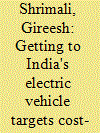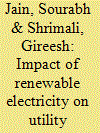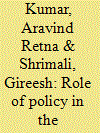|
|
|
Sort Order |
|
|
|
Items / Page
|
|
|
|
|
|
|
| Srl | Item |
| 1 |
ID:
109316


|
|
|
|
|
| Publication |
2011.
|
| Summary/Abstract |
Using a panel data over 50 US states and years 1991-2007, this paper uses a state fixed-effects model with state-specific time-trends to estimate the effects of state policies on the penetration of various emerging renewable electricity sources, including wind, biomass, geothermal, and solar photovoltaic. Renewable portfolio standards with either capacity or sales requirements have a significant impact on the penetration of all types of renewables-however, this impact is variable depending on the type of renewable source: it is negative for combined renewables, wind, and biomass; and positive for geothermal and solar. Further, clean energy funds and required green power options mostly result in increasing the penetration of all types of renewables. On the other hand, voluntary renewable portfolio standards as well as state green power purchasing programs are found to be ineffective in increasing the penetration of any type of renewable source. Finally, economic variables, such as electricity price, natural gas price, and per capita GDP as well as structural variables, such as league of conservation voters rating and the share of coal-generated electricity are found to be generally insignificant, suggesting the crucial role of policy in increasing the penetration of renewables.
|
|
|
|
|
|
|
|
|
|
|
|
|
|
|
|
| 2 |
ID:
125862


|
|
|
|
|
| Publication |
2013.
|
| Summary/Abstract |
Often, a goal of renewable energy policies is the development of domestic renewable energy technology manufacturing capacity. The Jawaharlal Nehru National Solar Mission (NSM) in India is an example; besides targeting an installation of 20 GW of grid-tied solar power capacity, it includes a domestic content requirement (DCR) to strengthen a solar photovoltaic manufacturing base. We ask whether the DCR of the NSM will be effective in ensuring the global competitiveness of the beneficiary sector. Our analysis reveals three observations that indicate this outcome is unlikely: (1) the manufacturing base has become less competitive over time, (2) developers may be favoring thin-film technology, thereby bypassing the DCR, which applies specifically to crystalline silicon cells and modules and (3) gaps in the Indian innovation system are likely to prevent a return to competitiveness by solar photovoltaic manufacturers. In particular, a comparison with the Chinese innovation system indicates shortcomings in the Indian innovation system of R&D capabilities, coordination of resource provision and complementary industrial strengths. Given these observations, we suggest that policymakers remove the solar photovoltaic DCR from the NSM.
|
|
|
|
|
|
|
|
|
|
|
|
|
|
|
|
| 3 |
ID:
179739


|
|
|
|
|
| Summary/Abstract |
In the context of India's ambitious electric vehicle targets, we examine two related questions. First, based on lifetime costs, which electric vehicles need to be subsidized? Second, based on lifetime subsidies, which subsidy option would be the most cost-effective? We find that electric two-wheelers, three-wheelers, four-wheeler-taxis, and buses do not need to be subsidized given that they are already cost competitive with comparable vehicles using internal combustion engines. We also find that personal cars and long-haul trucks need to be subsidized significantly, by one-third to one-half of the upfront costs. Finally, we find that an upfront subsidy is the most cost-effective subsidy option, followed by a per kilometer subsidy, which is effectively 19–31% costlier, whereas financing subsidies are found to be the least cost effective. Our results suggest that a cost-effective policy in India would be to subsidize only personal cars and long-haul trucks, while using the upfront subsidies.
|
|
|
|
|
|
|
|
|
|
|
|
|
|
|
|
| 4 |
ID:
132684


|
|
|
|
|
| Publication |
2014.
|
| Summary/Abstract |
The Jawaharlal Nehru National Solar Mission (JNNSM), India×s flagship policy for solar energy deployment, includes an increasingly strict Domestic Content Requirement (DCR) intended to promote the domestic crystalline photovoltaic solar industry. We examine the impact of the JNNSM DCR on the utilization of domestic and domestic crystalline silicon modules. Using a plant-level database of approximately 250 plants, we show that the first, and weaker, version of the policy accomplished its intention of promoting domestic crystalline silicon modules. However, the second, and stricter, version of the policy has not been as effective: it appears to have promoted the use of foreign thin film modules instead. This analysis shows that the tightening of the DCR was associated with leakage to foreign thin film modules. This suggests that DCR policies need to be comprehensive in scope to ensure that they achieve a goal of using only domestic content; however, policymakers should appropriately assess the welfare impacts of such restrictions.
|
|
|
|
|
|
|
|
|
|
|
|
|
|
|
|
| 5 |
ID:
186486


|
|
|
|
|
| Summary/Abstract |
Declining levelized costs of renewable energy have become a driving force in supporting renewable energy in India; the levelized cost of wind and solar has plummeted to between 3.3¢/kWh and 4¢/kWh. However, limited research exists on the impacts of renewables on the finances of Indian distribution utilities. The present study examines the financial impact of incremental penetration of the hydro, solar, and wind alternative in the generation mix of the distribution company of the Indian state of Madhya Pradesh. Using real-time 15-min interval data and a merit-order-dispatch model, the study quantifies the merit-order-effect and assess the potential savings from renewables. The results indicate that depending upon the penetration level under demand growth cases, renewable integration could lower the power purchase cost of Indian utilities by up to 11%. Wind produces most savings between 0.11¢/kWh and 2.71¢/kWh followed by solar −0.17¢/kWh and 2.56¢/kWh and hydro −0.32¢/kWh and 2.05¢/kWh. The savings will increase with rising electricity demand and plummeting costs of renewables. Integrating moderate levels of renewables no longer presents economic-environment trade-offs and can simultaneously meet multiple policy goals of energy affordability and environmental sustainability.
|
|
|
|
|
|
|
|
|
|
|
|
|
|
|
|
| 6 |
ID:
112934


|
|
|
|
|
| Publication |
2012.
|
| Summary/Abstract |
Many states have adopted financial incentives to encourage market deployment of solar energy technology. This paper employs a cross-sectional time-series approach to evaluate the extent to which state solar financial incentives systematically encouraged market deployment of solar photovoltaic (PV) technology from 1997 to 2009. The results demonstrate that states offering cash incentives such as rebates and grants experienced more extensive and rapid deployment of grid-tied PV technology than states without cash incentives over the study period. The analysis also finds that the presence of state renewable energy portfolio standards and specific solar carve-out provisions within them heavily influenced the market deployment of grid-tied solar PV technology through 2009.
|
|
|
|
|
|
|
|
|
|
|
|
|
|
|
|
| 7 |
ID:
110695


|
|
|
|
|
| Publication |
2011.
|
| Summary/Abstract |
Burning of biomass for cooking is associated with health problems and climate change impacts. Many previous efforts to disseminate improved stoves - primarily by governments and NGOs - have not been successful. Based on interviews with 12 organizations selling improved biomass stoves, we assess the results to date and future prospects of commercial stove operations in India. Specifically, we consider how the ability of these businesses to achieve scale and become self-sustaining has been influenced by six elements of their respective business models: design, customers targeted, financing, marketing, channel strategy, and organizational characteristics. The two companies with the most stoves in the field shared in common generous enterprise financing, a sophisticated approach to developing a sales channel, and many person-years of management experience in marketing and operations. And yet the financial sustainability of improved stove sales to households remains far from assured. The only company in our sample with demonstrated profitability is a family-owned business selling to commercial rather than household customers. The stove sales leader is itself now turning to the commercial segment to maintain flagging cash flow, casting doubt on the likelihood of large positive impacts on health from sales to households in the near term.
|
|
|
|
|
|
|
|
|
|
|
|
|
|
|
|
| 8 |
ID:
117239


|
|
|
|
|
| Publication |
2013.
|
| Summary/Abstract |
This paper aims to address two timely energy problems. First, significant low-cost energy reductions can be made in the residential and commercial sectors, but these savings have not been achievable to date. Second, billions of dollars are being spent to install smart meters, yet the energy saving and financial benefits of this infrastructure - without careful consideration of the human element - will not reach its full potential. We believe that we can address these problems by strategically marrying them, using disaggregation. Disaggregation refers to a set of statistical approaches for extracting end-use and/or appliance level data from an aggregate, or whole-building, energy signal. In this paper, we explain how appliance level data affords numerous benefits, and why using the algorithms in conjunction with smart meters is the most cost-effective and scalable solution for getting this data. We review disaggregation algorithms and their requirements, and evaluate the extent to which smart meters can meet those requirements. Research, technology, and policy recommendations are also outlined.
|
|
|
|
|
|
|
|
|
|
|
|
|
|
|
|
| 9 |
ID:
176706


|
|
|
|
|
| Summary/Abstract |
As India implements its Nationally Determined Contributions (NDC), via an ambitious renewable energy target of 175 GW of renewable energy by 2022, it is faced with an opportunity to further reduce greenhouse gas emissions. This opportunity is provided by the average cost of solar (and wind) energy falling below the variable cost of generating power from many existing coal plants. This indicates that, while other potential uses exist (e.g., making coal plants flexible), such expensive brownfield coal plants could potentially be economically retired today by simply switching to buying power from new solar plants. For example, by switching to a solar plant from a sample 5-year coal plant, the savings can be 33.90% in net present value terms. Further, while the savings on energy procurement is obvious, there could also be savings on committed contractual obligations on paying fixed costs, via a process called securitization. For example, using cashflow analysis, we show that retiring a sample 5-year old coal plant can save an additional 31.57% in value. We also discuss plausible regulatory changes, for which there are precedents in India and elsewhere, that would enable this cost-effective transition to a deeper penetration of renewable energy via retirement of expensive coal plants.
|
|
|
|
|
|
|
|
|
|
|
|
|
|
|
|
| 10 |
ID:
177430


|
|
|
|
|
| Summary/Abstract |
The Government of India plans to install 175 GW of renewable energy projects by 2022, and 275 GW by 2027. In meeting these goals, the Indian power sector faces twin challenges: first, managing renewable energy will require increased flexibility in the system; second, there will be under-utilization of existing coal-based plants, which would stress the economics of not only individual plants but also the overall power sector. This creates a need to explore the conversion of existing baseload coal plants as flexible resources. Our analysis shows the following: first, the incremental costs for converting baseload coal plants to flexible ones would be only 5%–10% of the total costs of baseload plants in net present value terms or 8%–22% in levelized terms; second, flexible coal may be the most cost-effective flexible solution in the near-term, by a factor of approximately 4–22, when compared to lithium ion batteries or pumped hydro. Finally, while we have provided an indicative analysis of additional costs of converting baseload coal plants into flexible ones, we recommend that flexible coal be procured cost-effectively using appropriate market mechanisms, such as capacity auctions.
|
|
|
|
|
|
|
|
|
|
|
|
|
|
|
|
| 11 |
ID:
125693


|
|
|
|
|
| Publication |
2013.
|
| Summary/Abstract |
India's ambitious goals for renewable energy raise many questions regarding the nature of investment required. We conduct financial modeling of actual renewable projects in India; and derive the following insights. First, the high cost of debt is the most pressing problem: higher cost and inferior terms of debt in India may raise the cost of renewable energy by 24-32% compared to the U.S. Second, even if cost of debt goes down, loan terms - including short tenors and variable interest rates - will become significant impediments, given that they add 13-14% to the cost of renewable energy in India compared to the U.S. Finally, due to the high cost of debt, policy lessons from the U.S. and Europe; which focus on finer instruments such as duration of revenue-support, revenue-certainty, investor-risk-perception, and completion/cost-certainty; are not likely to be as effective, with potential impacts on the cost of renewable energy in the 3-11% range. In fact, we find that an interest-rate subsidy, which reduces the cost of debt, reduces the overall subsidy burden by 13-16%. This suggests that Indian policymakers need to prioritize the provision of low-cost, long-term debt and take a closer look at the successful efforts by China and Brazil.
|
|
|
|
|
|
|
|
|
|
|
|
|
|
|
|
| 12 |
ID:
181807


|
|
|
|
|
| Summary/Abstract |
Hawaii's 100% Renewable Portfolio Standard target has led to rapid growth in renewable generation resources. This has resulted in grid issues given the islanded nature of Hawaii's grid. The state has decided to use battery storage in its grid to address these issues. This motivates us to try to understand the various business models in the state and the minimum set of barriers that must be overcome for its successful deployment. We achieve the former by assessing the projects in the state and identifying the dominant business models. For the latter, we use a barrier-solution framework that posits the minimum set of barriers that must be met for the successful deployment of battery storage business models and we verify it by identifying the role of various policies/drivers in supporting these business models. As a result, we find predominantly three business models in Hawaii: Co-located Front-of-the-Meter, Behind-the-Meter, and Aggregated Behind-the-meter. We also verify that at least one barrier from barrier categories associated with market demand and project economics along with all the barriers related to interconnection and market participation must be addressed for successful deployment of battery storage. Based on these findings, we give recommendations to policymakers seeking to develop a battery storage market.
|
|
|
|
|
|
|
|
|
|
|
|
|
|
|
|
|
|
|
|
|